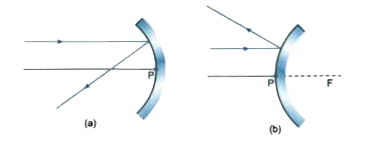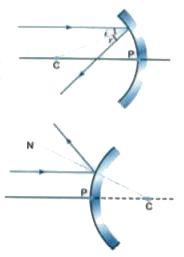Why does a ray of light parallel to the principal axis
(i) bend towards the principal axis in the case of a concave mirror and
(ii) goes away from the principal axis in the case of convex mirror as shown here ? 
Text Solution
A ray of light incident on any spherical mirror follows laws of reflection .
(i) In case of a concave mirror, the line joining the point of incidence ray and the centre of curvature forms the normal as shown. The reflected ray goes on the other side of the normal following laws of reflection .

(ii) In the case of convex mirror, the normal at the point of incidence is as shown. The reflected ray goes on the other side of the normal. Following laws of reflection as shown. Hence, it goes away from the principal axis.
|
Updated on:21/07/2023
Topper's Solved these Questions
- BOOK - VK GLOBAL PUBLICATIONCHAPTER - LIGHT-REFLECTION AND REFRACTIONEXERCISE - SOME IMPORTANT NUMERICALS (FOR PRACTICE)19videos
LIGHT-REFLECTION AND REFRACTION
- BOOK - VK GLOBAL PUBLICATIONCHAPTER - LIGHT-REFLECTION AND REFRACTIONEXERCISE - PROFICIENCY EXERCISE (Short Answer Questions-I)1videos
LIGHT-REFLECTION AND REFRACTION
- BOOK - VK GLOBAL PUBLICATIONCHAPTER - LIGHT-REFLECTION AND REFRACTIONEXERCISE - SOME IMPORTANT NUMERICALS31videos
LIGHT-REFLECTION AND REFRACTION
- BOOK - VK GLOBAL PUBLICATIONCHAPTER - ELECTRICITYEXERCISE - SOME IMPORTANT NUMERICALS12videos
ELECTRICITY
- BOOK - VK GLOBAL PUBLICATIONCHAPTER - MAGNETIC EFFECTS OF ELECTRIC CURRENTEXERCISE - HOTS (Higher Order Thinking Skills)22videos
MAGNETIC EFFECTS OF ELECTRIC CURRENT
Similar Questions
Knowledge Check
- Question 1 - Select One
A ray of light is incident on a concave mirror. If it is parallel to the principal axis, the reflected ray will
Apass through the focusBpass through the centre of curvatureCpass through the poleDretrace its path - Question 2 - Select One
When a ray of light travelling parallel to the principal axis of a concave mirror strikes at the polished surface of mirror, the reflected ray
Ais sent back along the same directionBpasses through the principal focus of mirrorCpasses through the centre of curvature of mirrorDpasses through the pole of mirror - Question 3 - Select One
A ray parallel to the principal axis after reflection from a concave mirror will pass through
Aprincipal focusBprincipal axisCradius of curvatureDcentre of curvature
Define principal axis of a spherical mirror.
View SolutionDefine principal axis of a spherical mirror.
View SolutionA parallel beam of light, parallel to the principal axis of a concave mirror, on reflection meets at the :
View SolutionDraw ray diagram to shown the principal focus of a (i) concave mirror, (ii) convex mirror.
View SolutionA ray of light passing through focus of a concave mirror becomes parallel to the principal axis of the mirror on reflection. Comment. Is the reverse true ?
View Solution

